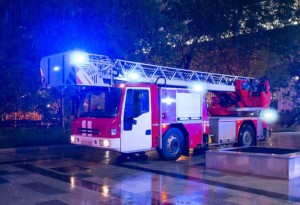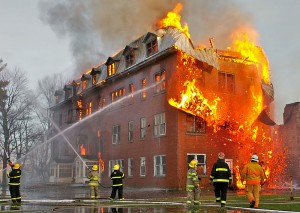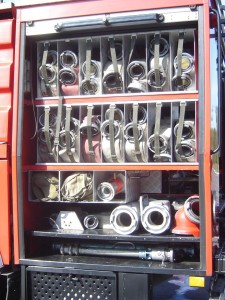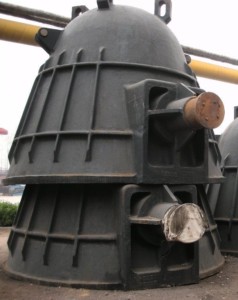 In this post I will finally go into more details on reactive maintenance. I already explained in my last post that I am missing the reactive maintenance in the eight pillars of Total Productive Maintenance (TPM), as well as preventive maintenance being often the better approach. The goal of reactive maintenance is to resolve breakdowns quickly to minimize the delay. This often includes a spare-parts management to decide which spare parts to keep in stock and which ones to order. It also helps to get a better understanding of your system to know what you are more likely to need and what not. A good analogy is the fire department, where speed is also (or even more) critical. Let’s look at the details:
In this post I will finally go into more details on reactive maintenance. I already explained in my last post that I am missing the reactive maintenance in the eight pillars of Total Productive Maintenance (TPM), as well as preventive maintenance being often the better approach. The goal of reactive maintenance is to resolve breakdowns quickly to minimize the delay. This often includes a spare-parts management to decide which spare parts to keep in stock and which ones to order. It also helps to get a better understanding of your system to know what you are more likely to need and what not. A good analogy is the fire department, where speed is also (or even more) critical. Let’s look at the details:
Speed of Reactive Maintenance

Something broke and needs fixing. Now is not the time to complain or to blame, or to wonder how this could have been prevented. Now is the time to act. Hence, reactive maintenance sometimes has the nickname run-to-failure maintenance. If something breaks, time is critical. The broken equipment is probably stopping the material flow and causing customers and workers to wait. Therefore, a fast reaction is important.

A good analogy is the fire department or the emergency services. When the alarm comes, they do not start to gather their tools and load them in the fire engine, only to find out that the tank is empty. Instead, as much as possible is prepared and ready to go. The same should apply to reactive maintenance. The tools should already be in the toolbox or tool cart, and spare parts should be available. The tools should also be in working order. Having to walk back because you need an extra O-ring is wasted time.
Hence, great care should be taken in preparing and maintaining the toolkit. Do you carry the toolbox or roll it? Are there stairs in between? Make sure to select suitable tools and spare parts, and refill consumables like duct tape or O-rings after use. Include a spare battery as needed, for example for the voltage tester. Fire departments go to great length to optimize their reaction speed, and the same should apply to maintenance. Hence, you may look to your fire department for inspiration. If you are familiar with SMED, you may also look there for inspiration.
 Also make sure to have good standards on how to issue and respond to a breakdown. Have your people properly trained so they know what to do. This does not only include technical training, but guideline rules on how to prioritize tasks (preventive tasks are often less urgent than reactive tasks, and some breakdowns are less urgent than others), who to send to which problem.
Also make sure to have good standards on how to issue and respond to a breakdown. Have your people properly trained so they know what to do. This does not only include technical training, but guideline rules on how to prioritize tasks (preventive tasks are often less urgent than reactive tasks, and some breakdowns are less urgent than others), who to send to which problem.
The workload of the team should be balanced, including reactive tasks, preventive tasks, and maybe even some idle time. For example, paper mills often have a maintenance team idling next to the large paper machine. They have lots of free time. But once there is a breakdown, they have to run. It may not be as extreme in your company as in a paper mill, but try not to overload the maintenance team with work. Ideally, maintenance has work that they can drop anytime to fix a breakdown, although in reality this may not always be possible.
 Finally, make sure that the escalation channels from the troubled machine to the maintenance are in good order. It is troublesome if the operator has an urgent call for maintenance, but nobody picks up the phone. You may also use other types of (digital) escalation systems.
Finally, make sure that the escalation channels from the troubled machine to the maintenance are in good order. It is troublesome if the operator has an urgent call for maintenance, but nobody picks up the phone. You may also use other types of (digital) escalation systems.
Spare-Part Management
 Another important question is spare-part management. Here, the actions move a bit from reactive to preventive, as you are trying to predict which future spare parts you need. There are different key factors here: How likely do you need the part, how expensive is a delay in getting the part, how fast can you get one from the supplier, and how much does it cost to keep the part?
Another important question is spare-part management. Here, the actions move a bit from reactive to preventive, as you are trying to predict which future spare parts you need. There are different key factors here: How likely do you need the part, how expensive is a delay in getting the part, how fast can you get one from the supplier, and how much does it cost to keep the part?
 Spare parts that are cheap to keep because they are inexpensive, small, and have a long shelf life should be in stock on site. O-rings, screws, nuts, filters, and similar are commonly held in stock.
Spare parts that are cheap to keep because they are inexpensive, small, and have a long shelf life should be in stock on site. O-rings, screws, nuts, filters, and similar are commonly held in stock.- For more expensive parts, it depends on the speed of reordering. Does the supplier send out spare parts overnight, or is it a custom-made spare part with a three-month lead time? The faster the delivery is, the more likely you can get away with not having it in stock but instead wait for the replacement.
- Another consideration is how likely do you need the parts. In general, parts that are commonly needed are often better to be kept in stock, whereas infrequently needed parts may be ordered as needed to keep the inventory costs down.
- The last consideration is how expensive is it to wait on a spare part. If the delay in getting a spare part causes only minor subsequent troubles, then you may wait. For example, if one of your forklift breaks, it is only a small problem if you have twenty similar forklifts more. However, if the final automotive assembly line breaks down, then this will cost around $1 million per day.
 These are the main criteria for deciding which spare parts to have on stock, and which ones not. The cost of keeping the part and the speed of reordering are often known. The expense in waiting for a part can at least roughly be estimated. The real difficulties are in determining the likelihood of needing the parts, making spare-part management difficult. But it has to be done. Computer systems can help you here in deciding what to stock and what not. Pull systems like kanban can be used to automatically replenish consumed parts. But be prepared to have a large and costly inventory that sees little turnover compared to manufacturing inventory. It may be better than delays during a breakdown, but nobody knows what inventory is exactly right. Also make sure to keep track of your spare parts, replace expired parts, and keep them organized.
These are the main criteria for deciding which spare parts to have on stock, and which ones not. The cost of keeping the part and the speed of reordering are often known. The expense in waiting for a part can at least roughly be estimated. The real difficulties are in determining the likelihood of needing the parts, making spare-part management difficult. But it has to be done. Computer systems can help you here in deciding what to stock and what not. Pull systems like kanban can be used to automatically replenish consumed parts. But be prepared to have a large and costly inventory that sees little turnover compared to manufacturing inventory. It may be better than delays during a breakdown, but nobody knows what inventory is exactly right. Also make sure to keep track of your spare parts, replace expired parts, and keep them organized.
Understand Your System
 Similar to predictive maintenance, gather data over time to better understand your system, what parts you need, and where to focus on predictive and where to focus on reactive maintenance. Adjust your predictive and reactive maintenance standards and your spare-part inventory as your understanding of the system increases.
Similar to predictive maintenance, gather data over time to better understand your system, what parts you need, and where to focus on predictive and where to focus on reactive maintenance. Adjust your predictive and reactive maintenance standards and your spare-part inventory as your understanding of the system increases.
This concludes my overview of the different tools in maintenance, loosely based on the eight pillars of total productive maintenance (TPM). However, I am not yet done. In my next post I will have a critical look at total productive maintenance. Now, go out, fix your stuff when it breaks (or even before), and organize your industry!

I would say the key decision element is the cost to fix the problem. It is not only the repair cost, but the opportunity cost too. Maintenance, then, is organised to keep availability as highest as possible.
An example is in supercomputers maintenance. There is always a team close to them, in a room with some very few, expensive and critical spare parts. They do nothing but flying to the failure and fix it as soon as possible. The maintenance cost is high, but much lower than the damage they prevent being there. Requested up-time goes beyond 99,5%. The maintenance contractor faces very high penalties when being below.
Hello Juan, this, too, is a trade off between cost and benefit. The maintenance team on standby for the supercomputer makes sense, since a downtime is very expensive. Unfortunately, I cannot afford such a on standby maintenance team with spare parts for my laptop. Many maintenance applications will fall somewhere between the supercomputer and my laptop.
Also another important aspect to consider is to establish standards routines to diagnose the problem. In the good old days it was OPLs (One Point Lessons) but now you can leverage on augmented reality, apps etc.
Based on these routines we have to train 1st responders (maintenance staff) based on losses to reduce MTTR.